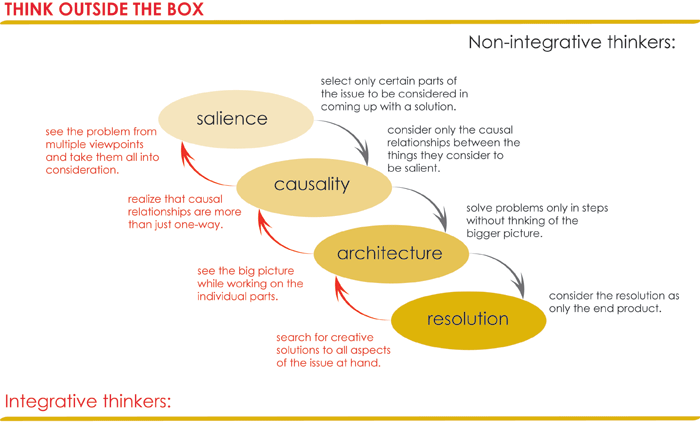

Integrative Thinking works on business models and Oesterwalder’s Business Model Canvas is the perfect specimen for integrative modeling…
As a University of Toronto Rotman graduate I was recently privileged to attend Roger Martin’s condensed version of Integrative Thinking course. Given two choices Integrative Thinking is not a solution of compromise, rather it is an outcome superior to both. While Martin arrived at his insights after studying successful Fortune 500 CEOs, the idea in itself was previously conceived. F. Scott Fitzgerald wrote in his 1945 book The Crack-up, that “The test of a first-rate intelligence is the ability to hold two opposing ideas in mind at the same time and still retain the ability to function. One should, for example, be able to see that things are hopeless yet be determined to make them otherwise.”
Conventional behaviour given two distinct choices (or models) typically generates either fear & avoidance or choose & move on. An integrative thinker rather than deciding one or the other may seek model clash and seek to leverage the choices to drive for new insights before proceeding. Martin’s definition in The Opposable Mind is therefore “The ability to face constructively the tension of opposing models and instead of choosing one at the expense of the other, to generate a creative resolution of the tension in the form of a new model that contains elements of the individual models but is superior to each”. A creative resolution from existing models / choices mines them for superior elements.
The process of analysis models is summarized by mining models to analyse three prominent stakeholder groups and generate the benefits of the choice. Do not analyse the shortcomings. Three patterns of integrative thinking modelling are 1) Double Down (when you love one model but desire a core benefit of the other) 2) Hidden Gem and 3) Decomposition. As we went through the context, mechanism, key questions and leverage points of each I pondered how Alex Oesterwalder’s Business Model Generation would be a perfect model for analysis. They are natural compliments. However, instead of analyzing using vaguely defined stakeholder groups, the models should break it down using Oesterwalder’s business model canvas.
Oesterwalder’s business model tool and framework distils businesses into the fundamentals. Using the business model canvas, he suggests design principles and a strategy to help modellers to create new, innovative designs.
An “integrative business model generation thinker” faced with two business models could easily plot these choices on the canvas and use Martin’s three patterns to create new ones. Doubling down, for instance, would extend the model they love in such a way as to produce the desire benefit of the other model. Understanding the core benefit of the other model may allow you to retain the benefits of your preferred while gaining many benefits of the other model. Perhaps your company desires the market share of a competitor, you may diagnose the essence of the model in the ability to establish numerous successful channels. If you’re primarily a resource driven company, a business in which innovations originate from the existing infrastructure (resources or back-office partners), then perhaps you can change the one channels. As an example. if you push harder (double down) on your resource driven business, perhaps you could leverage the backend business partners to forward integrate using their channels.
